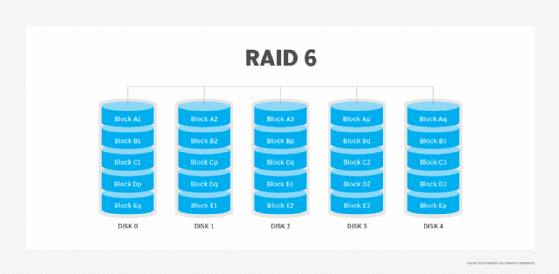RAID 6
What is RAID 6?
RAID 6, also known as double-parity RAID, is one of several RAID schemes that work by placing data on multiple disks and enabling I/O operations to overlap in a balanced way, improving performance.
Not all types of RAID, or redundant array of independent disks, offer redundancy, although RAID 6 does.
How does RAID 6 work?
RAID 6 uses two parity stripes, the practice of dividing data across the set of hard disks or SSDs, on each disk. It allows for two disk failures within the RAID set before any data loss.
In a conventional RAID, data is stored in different places on multiple hard disks, thereby increasing the aggregate mean time between failures and improving the fault tolerance.
In the approach known as RAID 4, the number of bits in data blocks on multiple disks is added up, and the total is kept on a disk called the parity disk. If a drive fails, data recovery uses the bits stored on the parity disk and bits remaining on the surviving drives. In RAID 5, the parity information is stored diagonally across all the disks in the RAID set. If a single drive fails, the original data is calculated from the parity information remaining on the surviving disks in the set.

What are the benefits of RAID 6?
RAID 6 offers high fault and drive-failure tolerance and can be used for environments that need long data retention periods, such as archiving. RAID 6 uses less storage than, for example, a RAID 10 array, which can only store half of its total storage capacity in data, as the other half is used by mirroring.
If a RAID 6 array contains the minimum number of disks -- four -- then it can only hold half the total disk capacity in data as well, because RAID 6 reserves the capacity amount of two drives to hold parity. The difference comes as disks are added.
The percentage of usable capacity increases as disks are added to a RAID 6 array. If eight disks are used in RAID 6, for example, parity -- which checks whether data has been lost or written over when it is moved from one place in storage to another or when it is transmitted between computers -- only consumes 25% of the disk capacity. A RAID 10 array dedicates half its capacity to protection, regardless of how many disks are used.
What are the disadvantages of RAID 6?
Each set of parities must be calculated separately using RAID 6. This slows write performance. RAID 6 is also more expensive because of the two extra disks required for parity. RAID controller coprocessors often handle parity calculations and improve RAID 6 write speed.
It takes a long time to rebuild the array after a disk failure because of RAID 6's slow write times. With even a moderate-sized array, rebuild times can stretch to 24 hours.
RAID 6 requires special hardware; it is important to use a controller specifically designed to support it.
Applications of RAID 6
The ability of RAID 6 to tolerate simultaneous failures without loss of user data makes RAID 6 a better choice than RAID 5 for mission-critical applications, such as in the healthcare, banking and defense sectors. When two drives fail with RAID 5, the user suffers data loss. A RAID 6 system, however, protects user data when two drives fail simultaneously.







